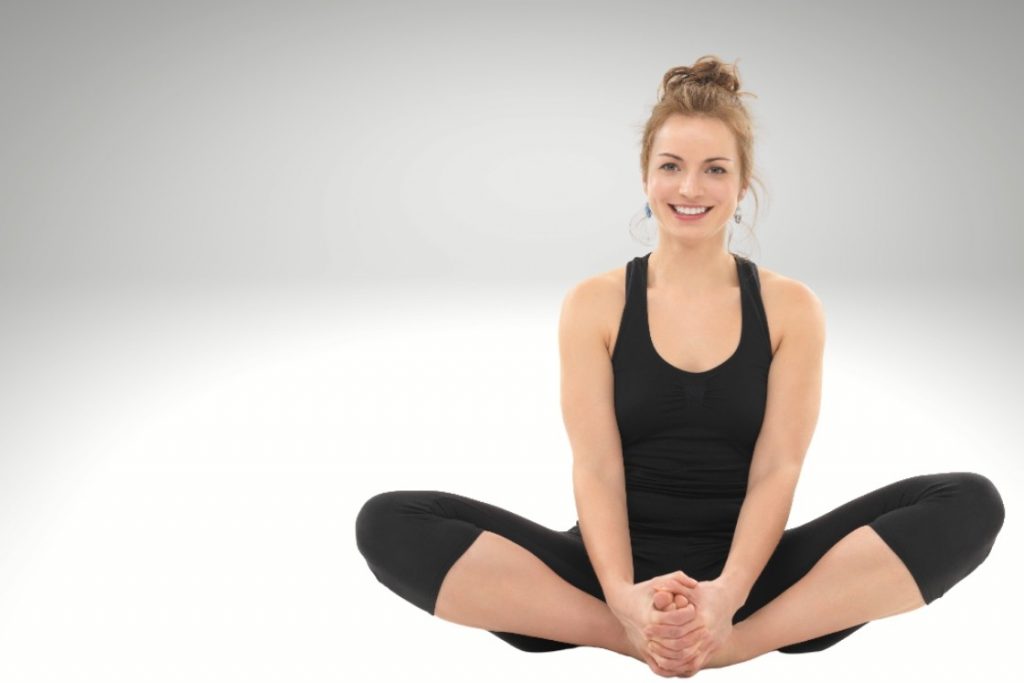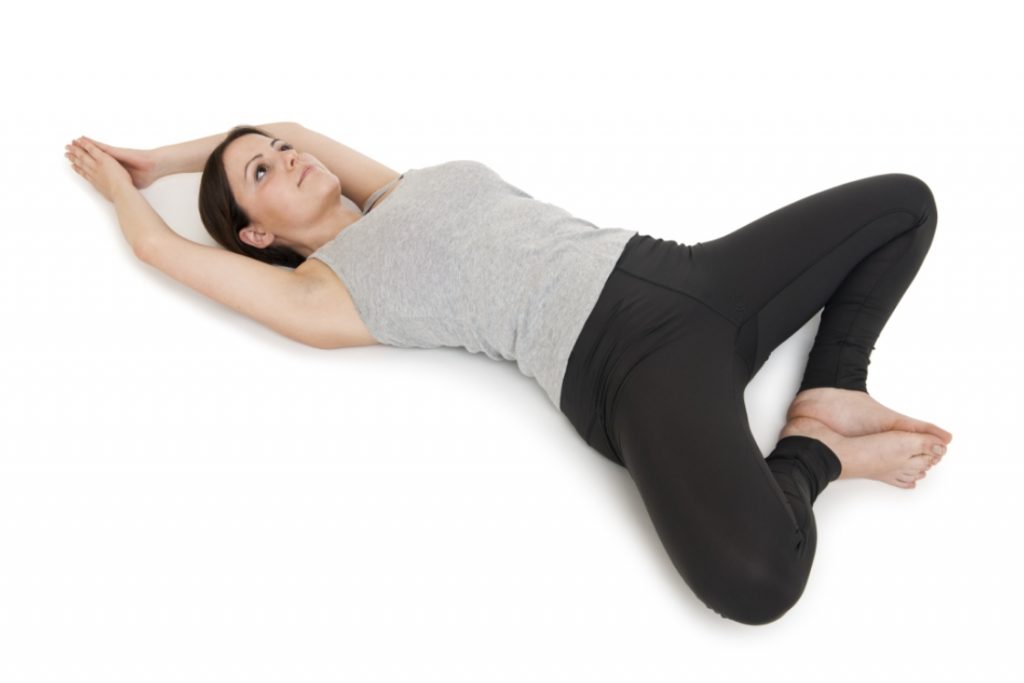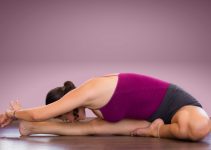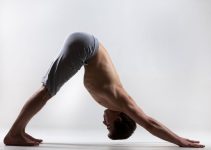
| Sanskrit | Baddha Konasana |
| Pronunciation | BAH-dah-cone-AHS-ana |
| Common | Bound Angle Pose, Bhadrasana, Cobbler Pose, Butterfly Pose, Throne Pose |
| Type | Seated |
| Level | Beginner |
| Stretches | Knee, Inner Thigh, Quadriceps, Groin, Hips, Lower Back, Ankles |
| Strengthens | Core, Pelvic floor, Psocas muscles, Spine, Shoulders |
Baddha Konasana is a typical seated meditative posture. It is one of the best hip-opener poses allowing a practitioner to release the energy lock in the lower body.
In some texts, you’ll found this pose under the name of ‘Bhadrasana – gracious pose‘ but feet placement and arrangement in both the pose are completely different. The similarity is just these are both sitting yoga poses.
In the case of Beginners seeking meditation practice, Baddha konasana is very easy because of its anatomical simplicity.
Meaning
In Baddha konasana, hands are grasped around toes so that legs can be bound at an angle. This way it can be described as ‘Baddha‘ means ‘bound’ or ‘restrained’; ‘Kona‘ means ‘angle’ and ‘asana‘ means ‘pose’ i.e. Bound Angle Pose.
In India, cobblers found to sit in the position of Baddhakonasana while mending shoes. Therefore, It is also called as cobbler’s pose.
A little transformation in this pose as an upside and downside movements of bend legs turns it into a Butterfly pose.
The ancient reference of Baddha konasana is usually taken from 15-century ancient yogic text Hatha Yoga Pradipika.
Baddha Konasana Practice Guide
It can be easily practiced by following some steps down in a cue.
Precaution & Contraindication
- Practitioners with the history of groin and Knee injury should avoid practicing Baddha konasana because it can create some more discomfort. However, these parts have the primary effect of asana.
- Menstruating women should avoid doing this asana in this period. It might result in complications concerned with the Periodic cycle.
- People with sensitive sciatica nerve are not advisable to perform advanced-level of baddha konasana but can go mild. Because advanced baddha konasana could result in intensifying the pain due to compression of the sciatic nerve.
Preparatory Pose
- Easy Pose (Sukhasana)
- Butterfly Pose (Titali asana)
- Reclining Hand-to-Big-Toe Pose (Supta Padagusthana)
- Hero Pose (Virasana)
Baddha Konasana Steps
- Begin by sitting in a Dandasana over the mat. Legs should be straight and back erect. Relax and find your place here.
- Now, gradually bend your knees and draw your heel close to the pelvis. Try to drop down your knees and touch them firmly to the ground.
- From here, grab your toes from the index, middle, and thumb finger to bring the heel as near as possible to the pelvic. Remember, do not force the heel and manage distance as your hip opening demands.
- Beginners can go for ankle and shin to bring heel nearer to their pelvis.
- Further, sit in a way that your tailbone and pubis remain at the same distance from the floor. Your pelvis should be in a neutral position and perineum parallel to the floor.
- Lengthen your torso from top of the sternum and firm the sacrum as well as shoulder blades while back straight. This will entitle the posture with the final touch.
- Always keep in mind that never try to push knees to the floor. You can push the head of the thigh bone as it will bring knees down in an unharmful manner. However, regular practice will set up ease.
- Hold the posture for 5 to 10 minutes or as per the comfort level while deep inhale and exhale.
Props & Modification
- Rounding of the lower back is the problem faced by newly enrolled practitioners when sitting flat on the floor.
- For them, a folded blanket under the sit bone assists after wishing some height to the posture.
- Tight hamstring makes it hard for knees to bounce back from the floor.
- So, one should use a folded blanket or if beginning then a block under thighs, after reaching maximum stretching. Apply some weight of around 10 to 15 pounds (as per requirements) on the inner groins.
- If the back is not strong to keep in posture for the given time period then one can take the support of the wall.
Follow up Pose
- Tree Pose (vrikshasana)
- Any forward and twisted pose can be done.
Variations
Following are the variation of Baddh konasana
1. Supta Baddha konasana

- Exhale from Baddha konasana and lean down your back torso flat on the ground. Touch the outer heels to each other after bringing feet together. Try to place feet nearer to the pelvis.
- Palms along the side and their back pressed the floor. After exhaling, ascertain abdominal contraction as your tailbone rushes close to the pubic bone.
- Use your hand in elongating in the lower back with stability in your spine on the tilting of the pelvis, maintain the position here. After an inhale and exhale, slowly let the knee open and experience a sense of stretch in your inner thighs and groins.
- Stay there for few minutes and exhale then exit after give a full & final stretch by pressing knees and lower back to the floor. Rollover to the side and firmly lift off your back trunk and then lower, respectively.
Prop & Modification
The stiffened hamstring may cause hindrance in achieving the final stretch in the Supta Baddha Konasana. So, practitioners with such conditions can use Bolder to support underneath the thighs or side knees for gradual opening or loosening of inner thighs.
Underdeveloped core muscle could also be the reason for the inability to keep knees hanged for some time. Therefore, a strap would be of great help in those practitioners.
2. Ardha Baddha konasana
- Begin with Baddha Konasana, spread your left leg to the left side, and place your right leg against the left inner thigh. Left toe in a flexed position.
- After inhale, Raise your both arms overheads spine should be straight and still here. Now, lean forward. Try to take hands as forward as possible. You can put bolder or any object to grab for.
- Remain in the position as per the comfort. Practice 5 to 10 minutes regularly to experience the suppleness in the inner thigh, groin, pelvis, hip muscles, etc.
Baddha Konasana Benefits
- Baddha Konasana is one of the best prenatal yoga postures. It helps in strengthening and lengthening up of pelvis, which restores the smooth delivery.
- Upside and downside movement in this asana improves the blood flow to the reproductive system. This results in the activation of sex cells to secrete sex hormones that govern sexual health in young and adults as well.
- Enhanced blood flow provides a nourishing effect over the prostate [efn_note] A CONCEPTUAL STUDY ON SCIENTIFIC ANATOMICAL APPROACH TOWARDS YOGA AASANA http://ayurpub.com/wp-content/uploads/2018/06/907-915.pdf [/efn_note] and kidneys including other excretory organs. Therefore, improve functioning and restore health.
- Holding in this asana promotes the operating range of muscles and joints as well. It helps in improving the flexibility [efn_note] Study of hatha yoga on flexibility and coordination of the human body by selected asana http://www.kheljournal.com/archives/2016/vol3issue5/PartA/3-6-4-366.pdf [/efn_note] of the inner thigh, hip abductor, pelvic mobility, etc.
- Deep breathing while sitting in Baddha Kona asana makes the respiratory system to add ample oxygen. This further loosen up the tightens muscles, slows down the breath, reduces heartbeat followed by raised blood pressure. Ultimately reduces stress and anxiety via its calm and soothing effect.
- Longer breath in Baddha Konasana can be helpful in increasing vital capacities which further can assist in Respiration.
- The compression of the sciatic nerve results in numbness, tingling sensation, weakness, and the worst is pain. Regular practice of this asana provides the deep stretch in the area governed by the sciatic nerve and relieve symptoms.
- Increased blood flow to the abdominal regions and butterfly movements of knees provides a massaging effect over the digestive organ. This results in enhanced metabolism and active digestion.
- The practice of Nasikagra Drishti while doing this asana helps in building focus and concentration.




